Life Magazine
December 1983

BARBRA PUTS HER CAREER ON THE LINE WITH 'YENTL' — AND LEARNS NEW LESSONS ABOUT HER POWER AND HER FEMININITY
By Anne Fadiman
Cover Photo by Greg Gorman
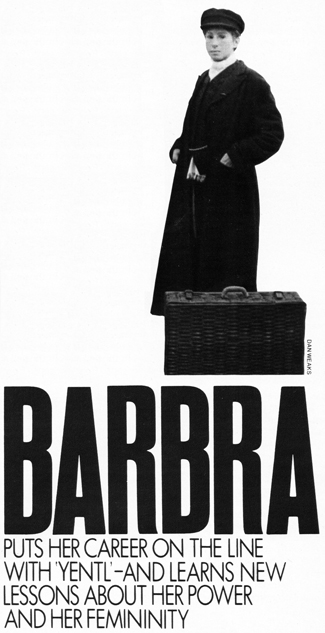
If you stop at the sign on Sunset Boulevard that says MOVIE STAR MAPS and fork over five dollars, the old man will sell you a Guide to Starland Estates and tell you that Barbra Streisand lives in Estate # 118. But, he will add honorably, "You can't see anything."
True enough. In front of the house is a stone wall, above the wall is an iron grating, above the grating is a chain link fence, and behind the fence is an opaque thicket of trees. To get inside, you talk into a little intercom, and if you pass muster, the electric gate—the Starland equivalent of a draw- bridge—swings silently open.
I pass muster. Inside, I wait briefly in a large white study containing a white piano and a white poodle. The white ashtrays have white match boxes, and the white pencils on the white desk have white erasers. In walks the woman who has been compared, at various points in her career, to an ancient oracle, a Babylonian queen, a vampire, a toadstool, a truffle, a martin, a hamster, an anteater, the Aswan Dam and a plate of hot pastrami. At five feet five, with squiggly blond hair, scant makeup, and what her former lover Jon Peters describes as "a foxy little body with a great ass," she bears no obvious resemblance to any of these items. She wears a work shirt and Jeans and looks at least 10 years younger than her age, which is 41.
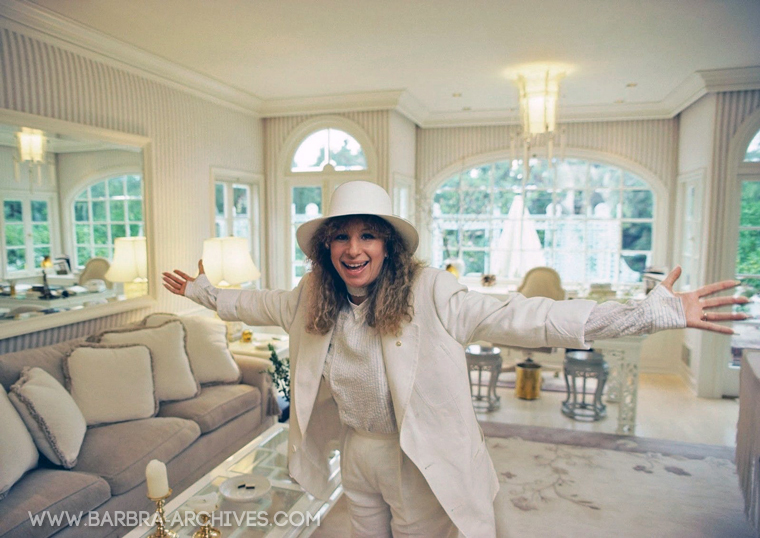
Photo: Douglas Kirkland
"Hi, I'm Barbra," she says helpfully. "I've got to listen to these tapes by noon today and thought, well, maybe you wouldn't mind listening with me." She is spending the week smoothing out the pop single versions of three songs from her movie Yentl. The original sound track uses only instruments common in Eastern Europe in 1904, when the movie takes place: violins, cellos, wooden flutes, panpipes, zithers. To alchemize the music into potential Top Forty gold, some of the songs have been reorchestrated with electric pianos, electric basses, drums and synthesizers. Streisand goes to the Lion Share recording studio every day and sits at an enormous console with two dozen levers, one for each instrument. She raises the volume of the violins a little on this phrase, softens the brass on that one. ("Barbra has the most incredible hearing in the world," says record producer Phil Ramone, who is master-minding the singles.)
Streisand pops a cassette labeled "The Way He Makes Me Feel" into a slot in the wall. Suddenly the white room is filled with a sound that seems to come straight from the sky, not from the Lion Share studio. It rises, falls, bends the tempo to the lyrics like audible taffy. Meanwhile, the real Streisand paces up and down with her hands in her pockets, a small figure set against the super- human backdrop of her.
"Do you like it?" asks the star who has been I known to consult the man repairing her barbecue on which take he prefers. Then, more anxiously, "Is it better in the movie?"
Barbra Streisand acted in Yentl, directed it, coproduced it, and co- wrote the screenplay—the first woman in history to take such complete control of a film. She appears in virtually every scene and is also the sole singer of the movie's 12 songs. The story of a young Polish girl named Yentl who disguises herself as a boy in order to pursue Talmudic studies at a yeshiva, the film began life as a 28- page tale by Isaac Bashevis Singer called "Yentl the Yeshiva Boy." (He wrote it in Yiddish in a single afternoon.) Streisand optioned the rights in 1968, long before Victor/Victoria, Tootsie and La Cage aux Folles made cross-dressing cinematically chic. In 1973 she read it aloud to Jon Peters, the hairdresser-businessman who is now a producer, during the first weekend they spent together, and told him, "Someday I'm going to make this." "I told her she was crazy." says Peters. "But I thought she was so brave. She had so much passion for it." In 1975, with Streisand's permission, Yentl was made into a successful Broadway play starring Tovah Feldshuh. Peddling the film to Hollywood, which has grave reservations about women directors, was a grueling process. Streisand's property ricocheted from Orion Pictures (financial cold feet) to PolyGram Pictures (personal fights with studio co-president Peters) to United Artists. "Everybody told her she couldn't do it," says Peters. "But Barbra was saying I'm going to drop everything and I'm going to work seven days a week and I'm going to fight on the phone to raise money, and then I'm going away for two years, and I'm going to film in a Communist country with machine guns and tanks, and her mother's calling her crying and begging her not to go, but she's saying I'm going to do it anyway." After nine months of overseas preproduction work and filming - the interiors in London, the exteriors in Czechoslovakia — Streisand delivered the picture to MGM/United Artists for $16.2 million, half her $3 million acting salary when Yentl went 11 percent over budget.
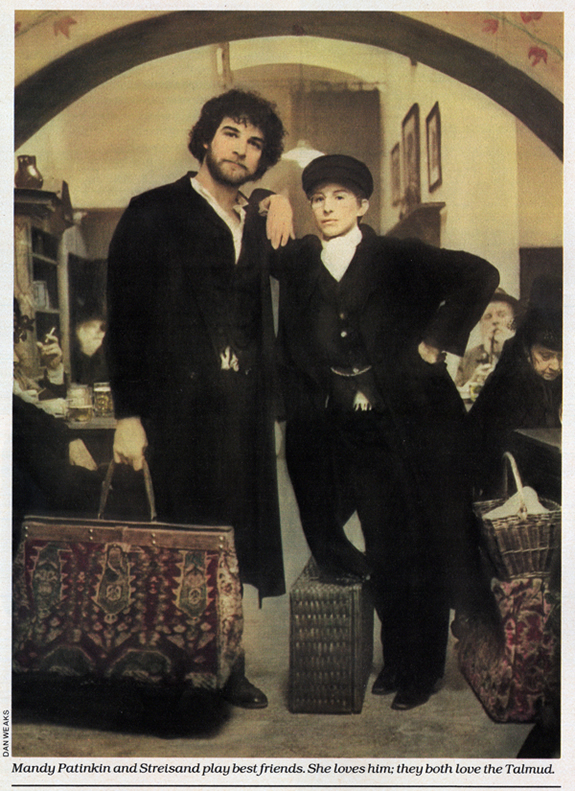 The story is a love triangle. Yentl falls in love with her yeshiva study partner, played by Mandy Patinkin, who won a Tony for his portrayal of Che Guevara in Evita. He in turn loves Hadass, a girl well schooled in the arts of service and self-abnegation, played by Amy Irving, star of The Competition and Honeysuckle Rose. Hadass's family forbids her to marry Avigdor, so, looking for a way to remain close to her, he persuades his buddy Yentl to marry her in his stead. This Yentl does, though she manages to avoid sexual contact with her new wife in order to preserve the secret of her gender.
The story is a love triangle. Yentl falls in love with her yeshiva study partner, played by Mandy Patinkin, who won a Tony for his portrayal of Che Guevara in Evita. He in turn loves Hadass, a girl well schooled in the arts of service and self-abnegation, played by Amy Irving, star of The Competition and Honeysuckle Rose. Hadass's family forbids her to marry Avigdor, so, looking for a way to remain close to her, he persuades his buddy Yentl to marry her in his stead. This Yentl does, though she manages to avoid sexual contact with her new wife in order to preserve the secret of her gender.
Streisand spends most of the movie covered from head to toe in a boy's black suit, her hair caught up under a short brown wig, her eyes hidden behind a pair of gold-rimmed spectacles, her eyebrows untweezed, her breasts compressed to preadolescent flatness by a special bra, and her celebrated nails lopped to the quick. "I didn't need to be beautiful here," she says. "So I gave the kind of attention I've always wanted for myself to Amy, who's every man's dream of a girl. So many times male directors just want you to get on with it, you know, enough powdering of the nose." Says Irving, "Barbra was always adjusting the lighting or the camera angle to make me look perfect. She'd fix my hair ribbons, brush an eyelash off my cheek, paint my lips to match the color of the fruit on the table. I was like her little doll that she could dress up. For the scenes where I had to laugh, she'd stand behind the camera pulling the strings of an imaginary Hadass doll, making it burp and cry until I'd completely crack up."
Neither Irving nor Patinkin had any difficulty relating to Streisand as a male. Says Patinkin, "She was a guy. Period. I never thought of her as a girl." Says Irving, "I'd hold her hand when she was directing and say, 'You're the cutest guy on the set.' I felt that way even in the scene where I kiss her. I was pretty excited, I mean, I'm the first female to have a screen kiss with Barbra Streisand! She refused to rehearse, but after the first take she said, 'It's not so bad, it's like kissing an arm.' I was a little insulted, because I believed so much that she was a boy that I'd sort of fallen in love with her."
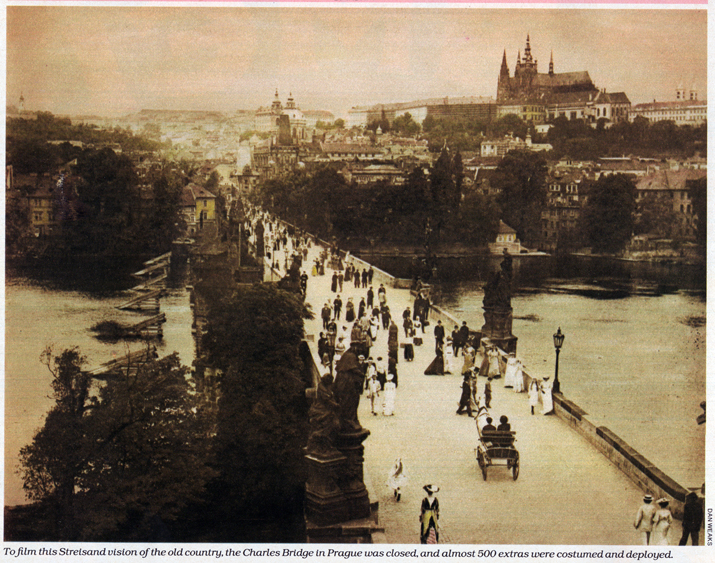
Now, sitting in the white study whose noncolor scheme was planned to be "distraction-free, just like Yentl's costume," Streisand tells me that while everyone around her was treating her like a man, she felt more and more like a woman. "As a director, which is considered a male role, I had enormous power. But the stronger I felt, the softer I would speak. People would say, 'God, can't you talk any louder?' But I just couldn't." Barbra Streisand's interest in exploring different sex roles is not new. As a small child, she used to enjoy smearing her mother's lip-stick all over her face. One day, she decided to try her grandfather's razor instead and was rushed to the hospital after she nearly cut off her lip. In Yentl, the face that was preserved in that Brooklyn emergency room blends in well with the androgynous features of the other yeshiva students. "Talmud students really do look quite feminine," she explains. "They have light pale skin because they are never out in the sunshine, and they sit on their behinds all day so they get soft feminine asses. I cast boys with big lips and pretty eyes. I also used some girls as boys, did you notice that? Some of them had kind of masculine faces, maybe a little peach fuzz on the upper lip, and they looked good in boys' clothing. I didn't want anybody to be 100 percent masculine or 100 percent feminine."
We adjourn for lunch to a 100 percent feminine room, a conservatory with pink walls and a pink-cloaked table set with Minton china and tiny porcelain flowers at each place. "Do you know the Jewish mystical concept of soul-sharing?" she asks, spearing the Chinese chicken salad with her vermeil fork. "Ummm, I love this ginger. I once wrote a scene where Avigdor and I are discussing friendship and wondering whether we might be soul mates. A man and a woman can share the same soul, you know. "
In Singer's short story, where the love triangle has strong homosexual overtones, Yentl finds a way to deflower the virginal Hadass on their wedding night. "I toyed with that," says Streisand, toying with her china teacup. "In my first draft of the script, I blew out the candle, and in the next shot you see the candle missing. So you know what Yentl did. But movies are too real, too literal. That would have been farcical. Even without it, the scene is erotic. I mean the taboos make it sexy, you know? The fear of homosexuality can be very sexy. The fear of men and women touching before marriage can be very sexy. Today we've kind of destroyed that mystery." She glops some Cool Whip on her dietetic pumpkin soufflé. "We've lost our wedding nights."
During the course of the next week, I spend a lot of time staring at Barbra Streisand. Hers is a face so uniquely constructed, so exquisitely surprising in its curves and planes, that one can look at it for hours—years, says Jon Peters—and never get bored. I tell her that when she was 20, critic John Simon wrote presciently that she was a cross between a tremulous young borzoi and a fatigued Talmudic scholar.
"Really?" she says. "Talmudic scholar? You're kidding! I hadn't even read 'Yentl' yet!" Then, more suspiciously, "What's a borzoi?"
"Uh, a dog." "What kind of dog?"
No avoiding it. "A dog with a long nose."
One day, when Streisand is sprawled on the carpet of her green and pink living room, I remark that I've heard she prefers to be photographed from the left. "Yeah," she says. "My nose is longer from the other side."
I ask if I can look. Thinking to myself that if I were a man I could never get away with this, I circumambulate America's biggest star and study, from every angle, the portion of her anatomy Time has called a shrine. To my untrained eye, the shrine looks equally well designed from all sides.
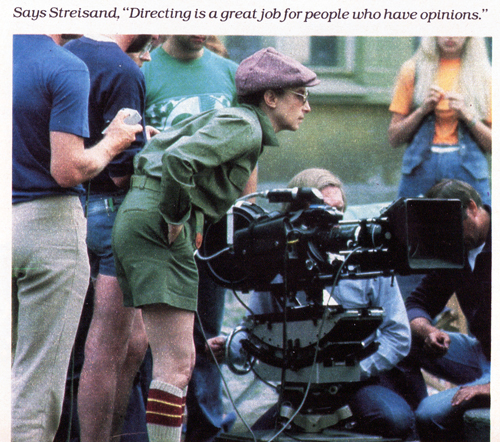
"No," says Streisand, "I have two very different sides of my face. My left side is more feminine. My right side is more masculine. In the movie I had myself photographed from the right to show a side of me that had hardly ever been seen. You know the scene after my father's funeral, where I look in a mirror and cut off my hair? I had a crack made in that mirror that would divide my face in half. Male and female."
In Isaac Bashevis Singer's story, Yentl's father, a scholar, dies before the narrative begins. In Barbra Streisand's film, he is alive for most of the first reel, teaching his daughter Talmud and planting seeds of intellectual curiosity. When he dies, it is Yentl, in a small cemetery, in the fading light of late afternoon, who performs what is traditionally a man's ritual and says the prayer of mourning called the kaddish. (For this scene, filmed in Czechoslovakia, Streisand temporarily moved the old gravestones to a hill because she liked the idea of the dead having a view.) Says Jon Peters, "Barbra was saying kaddish for her own father. She created him on film so she could love him and say good-bye to him. She buried her father in the movie."
Barbra Streisand's father, Emanuel Streisand, was a high school teacher with a master's degree in education who served as superintendent of schools at the Elmira Reformatory in upstate New York and also taught at a Brooklyn yeshiva. He died at 35, when Barbra was 15 months old, of what was thought for many years to have been a cerebral hemorrhage. His daughter assumed it was an inherited condition and feared that she, too, would die at 35. Only a year and a half ago did she learn that her father had actually died from an improperly treated epileptic seizure following a head injury. One morning Streisand spreads three photographs on the living room coffee table: yearbook portraits of her father from high school and college, and a picture of herself in yeshiva costume that she has just selected for the back of the Yentl sound-track album.

"I wasn't going to use this one," she says, "but then I thought, oh my God, that's my father. Look. The nose. The eyes. The shape of the face. Chin." It is true. The resemblance is uncanny. Streisand-as-Yentl looks like her father's younger brother, though in these pictures he was in fact only half her present age. Arranged neatly on the baby-pink bookcases in Streisand's living room, along with the rare art nouveau objects she collected before she became, as she puts it, "objected out," are rows of the classics: Alice in Wonderland, The Essays of Francis Bacon, The Works of Sophocles. These once belonged to her father. When he died, they were packed in boxes in the basement. "Then I discovered them and made them my books." she says. "My mother tells me I used to scribble all over them." She opens Gulliver's Travels and stares for a moment at the flyleaf, which is covered with childish drawings. "I guess you noticed I made Yentl love books too."
 Emanuel Streisand was also an athlete. "He played squash and tennis, when Jewish boys didn't do things like that," she says. "He was an adventurer. Yet he honored the Sabbath. Once when he was hitchhiking across the country, he put on his tefillin to say prayers at the Canadian border. They thought he was nuts and wouldn't let him through." (Tefillin are small leather boxes containing Hebrew scriptural passages.) She snaps the book shut. "You know, I was angry at him. Angry because he left me. My mother told me that after he died I used to crawl over to the window and look out, like I was still waiting for him to come home."
Emanuel Streisand was also an athlete. "He played squash and tennis, when Jewish boys didn't do things like that," she says. "He was an adventurer. Yet he honored the Sabbath. Once when he was hitchhiking across the country, he put on his tefillin to say prayers at the Canadian border. They thought he was nuts and wouldn't let him through." (Tefillin are small leather boxes containing Hebrew scriptural passages.) She snaps the book shut. "You know, I was angry at him. Angry because he left me. My mother told me that after he died I used to crawl over to the window and look out, like I was still waiting for him to come home."
She waited a long time. It was not until she began to make Yentl, the story of a woman who is both tormented and freed by her father's death, that she stopped feeling angry. In 1979 she visited Emanuel Streisand's grave on Long Island for the first time; in 1980 she endowed UCLA's Streisand Chair in Cardiology in his honor; in 1981, with her backing, the Emanuel Streisand School of the Pacific Jewish Center in Santa Monica was established.
A pivotal song in the movie, sung after the death of Yentl's father, is called "Papa, Can You Hear Me?" (When Streisand recorded the pop version, she broke down on the line "Papa, how I miss you / Kissing me good night" and had to scrap the rest of the take.) She appears to have taken the title literally. Once, when she was trying to decide whether to move a scene to another location at considerable expense, she thought, "I'll ask my father." Suddenly It started to rain. "So I knew we had to move," she says. "He was watching me." When Barbra Streisand was 22 years old and living in Manhattan, she and her husband, Elliott Gould, slept in a 300-year-old damask-draped bed that was sup- posed to look (as he explained to the upholsterer) "like the place Desdemona got strangled in." At one time she planned to install in its side a small refrigerator to hold bricks of Breyers coffee ice cream. This is still Streisand's favorite food. One afternoon she remarks sadly that Breyers bricks are not available in Los Angeles. "All you can get out here is Haagen-Dazs," she says. "I don't like expensive ice creams. The richer they are, the more I hate them. Breyers is like this thin, icy ice cream with air bubbles. It reminds me of Brooklyn."
Brooklyn once seemed to her a place with no redeeming features, not even its ice cream. She called it the home of "baseball, boredom and bad breath." When she appeared on Broadway as Miss Marmelstein in I Can Get It For You Wholesale, her first major part, the Playbill bio stated that she had been born in Madagascar and raised in Rangoon. (Later she changed it to Zanzibar and Aruba.) Today, as she sips a decaffeinated cappuccino made with skim milk and Sweet 'n Low (a sort of liquid Breyers brick), she describes the apartment her family moved to after her father's death. "Pulaski Avenue, Willamsburg," she says. "My brother had a folding cot, and my mother and I shared a bed. My grandmother and grandfather lived in the other bedroom, and the third room just had a table and a credenza. We never had a couch. Couches to me were, like, what rich people had."
She notices me glancing around the room. "Yeah, I've got a lot of couches now. I love couches."
Whenever a prospective beau called on Streisand's mother, the future director hid under the dining table and eavesdropped. "I remember listening to the adults misinterpret each other," she says. "I remember thinking, oh no, he's talking about one thing, she's talking about another, and they don't know it. I hated those men. Once I saw a man kissing my mother. I thought he was killing her. Except she was laughing." absence prevented her from be- coming a flirtatious woman. "I never learned how to manipulate men," she says. "Because you don't learn feminine wiles from women. You learn them from men. You learn them from the daddy that you can run up to at the end of the day and throw your arms around, and the next day he buys you a new dress."
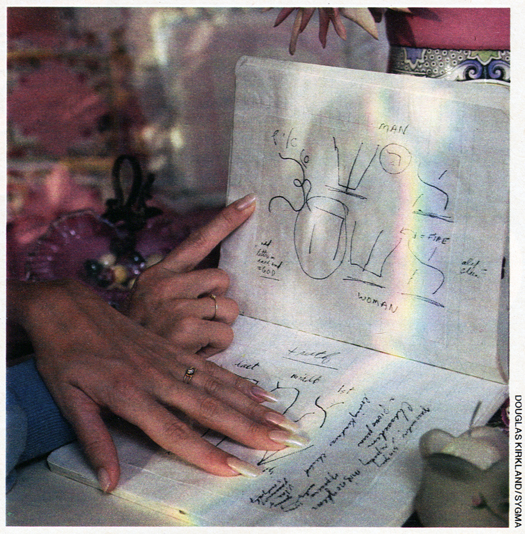
One morning she ushers me upstairs to her dressing room so I can smell three homegrown roses on her makeup table. The bulletin board on the opposite wall is plastered with old Mother's Day cards and snapshots of Jason, her son by Elliott Gould, who will be 17 this month. Jason looks very much like her and even more like Yentl. The seven-time Grammy winner plays only one-finger piano, but her son is an accomplished musician. When Streisand turned 40 in London in April 1982, Jason and Kim Skalecki, her personal secretary, sent her a birthday videotape of her friends, her dogs and her flowers. It was scored with Jason's piano music.
"Isn't that an incredible smell?" she says, holding up the vase. "Roses from a store just aren't the same. They're all shriveled up, and they don't smell. You have to have your own garden."
Since the end of her relationship with Jon Peters, the gardener has lived alone with Jason. She tells me later that she is learning to date. "Funny word," she says. "I'm learning all the things I never learned when I was young. Those little tricks about dealing with men that I always thought were manipulative but are really just smart. And feminine, I suppose." She bats her eyes in a momentary burlesque of femme fatale seductiveness, then laughs at herself. "I became famous so young that I missed the social experiences most women have. And when I was in high school I was very shy. Hardly went on a date. I met Elliott when I was nineteen, and we were together for eight years. And then a few years later I met Jon." Barbra Streisand and Jon Peters had much in common. Both had lost their fathers when they were children. And long before Yentl's explicit exploration of androgyny, each was intrigued by the other's combination of masculine and feminine qualities. "Barbra's this cute little thing," says Peters, "but she's also six feet tall when she wants to be. I mean, over the years we had some major fights. Once she hit me with a chair. Which I liked." Says Streisand, "Jon is a very macho man. He's got scars all over his hands from fighting, but he's very good at hair and clothes. Putting things together. Telling me what to wear." Peters, who was sent to a correctional Institution for truancy and theft before he was 12 and married before he was 15, says, "My youth was about getting laid and big tits and all those physical attributes of women. I learned about real women from Barbra. I learned about power. And equality. When we first met I thought men should get their way ninety percent of the time and women ten percent. Then, when we began living together, it began to change. Eighty-twenty. Seventy-thirty. It was like a sliding scale. Fifty-fifty. When she went to do Yentl it got to be ninety-ten the other way."
Peters had listened to Streisand talk about Yentl, and tried to dissuade her from making it, ever since she read Singer's story aloud to him that first weekend. Then, in 1978, he walked into their house at two o'clock one morning. "She came out with a pipe and a hat, and I thought It was a guy robbing the house," he says. "I was going to punch him in the mouth." That afternoon the intruder had rented a yeshiva student's outfit from the boys' department of Western Costume. Thereafter, Peters kept quiet about the impossibility of Streisand's playing a young boy.
Says Streisand,"When I left for Europe we weren't formally separated. But we were. I had to make the choice. It was like putting a knapsack on your back and going out to seek your fortune." (This is what Yentl does herself, thereby giving up all her prospects for conventional happiness.) When Peters visited her on location in Czechoslovakia, he was revolted by the smell of urine and sewage. "Barbra never noticed," he says. "There were flies in that village as big as beetles, but they never bothered her. She just swatted them." Last August, when he finally saw the film whose production he had tried to prevent, he stood up and cheered.
"I always wanted to be a scholar like my father," says Barbra Streisand. "I want to know everything." While researching Yentl, she talked to dozens of Orthodox, Conservative and Reform rabbis. "I asked them questions about men and women," she says. "You see, a first century rabbi named Eliezer said that he who teaches his daughter Jewish scripture is corrupting her. But later rabbis said all fathers must teach their children scripture. And some feminist rabbis told me the word 'children' means both sons and daughters. It's all a matter of interpretation. That's why Jews argue, you see? Where there are two Jews there are three opinions." For three years Streisand kept track other research in a series of children's composition books, the kind with "Periods 1-8" printed inside the cover. Interspersed with her notes on Jewish mysticism are such jottings as "Gentile thinks so you're the chosen people huh? We are chosen not for privilege but for responsibility."
After Amy Irving was cast in the part of Hadass, she received a package of books from Barbra Streisand. "They were all about how to make a kosher kitchen," says Irving. "How to prepare the fish, how to bake the bread. Barbra wanted me to know what Hadass would know." When Mandy Patinkin arrived on the set in London, he found a huge box on his dressing table. "What was Barbra giving me?" he says. "Cookies? Pastry? I unwrapped it and found a seven-volume set called The Legends of the Jews. Things that Avigdor would know."
The person whose opinion Streisand most values, and whose criticism she most fears, is the author of Yentl, Isaac Bashevis Singer. She is aware that he does not have high hopes for the movie. "Very curious I'm not," he says. "Barbra Streisand has made herself the producer, director, writer and the actress. That is too much. And she made a musical about Yentl. Yentl did not go to the yeshiva to learn to sing. She went to the yeshiva to study Talmud. Of course, maybe a miracle will happen and it is good."
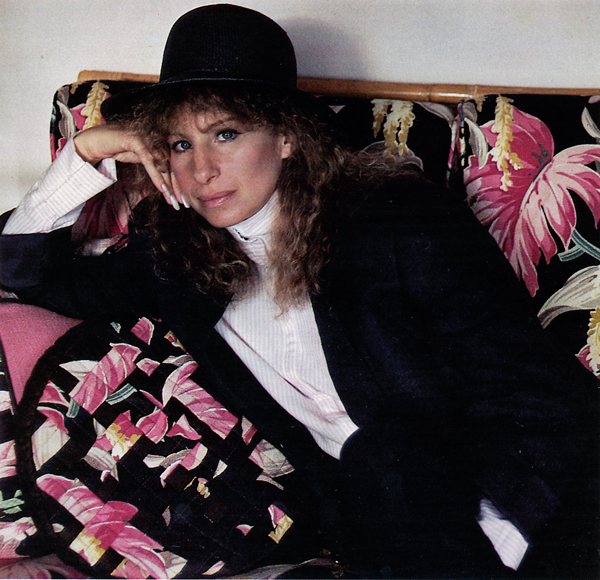
Photo: Douglas Kirkland
Streisand believes that Singer will at least like the movie's settings, many of which were chosen expressly to match descriptions in his story. Before deciding on Czechoslovakia, Streisand and her coproducer, Rusty Lemorande, scouted exteriors in Poland, Austria, Hungary, Yugoslavia and Romania. Lemorande made a 15- minute Super-8 film of everything Streisand wanted to re-create in Yentl: walls, doors, fountains, houses, cemeteries, synagogues, even a stork's nest. As I watch it on Streisand's giant TV screen, I notice a small black-coated figure with his hands in his pockets walking down a side street in Tabor, Czechoslovakia. Only when the moment is replayed for me do I realize it is Streisand, wearing her outfit from Western Costume.
Next Streisand plays a short film she made with Terry Rawlings, Yentl's editor, as a good-bye present to the cast and crew. While she sings "People," that old heartbreaker from Funny Girl, the camera pans from face to face, paying tribute to all the people who would never appear on the wide screen. "Everyone is interested in what I did on Yentl," she says. "But never in what we did." The project does indeed have the reputation of being a one-woman show, or as one gossip columnist put it, "the Taj Mahal Barbra Streisand built for herself." Yet the people who worked on the Taj Mahal with her have confounded her image as a tantrum-thrower (chiefly broadcast seven years ago by Frank Pierson, her director on A Star Is Born) by sending a letter to dozens of newspapers and magazines averring that Streisand never once lost her temper. She, in turn, liberally acknowledges her debts to her fellow Taj builders, from her casting director, Cis Corman (who has been her closest friend since Streisand was 16) to her lyricists, Alan and Marilyn Bergman (who first advised her to make this a musical, so Yentl would have an outlet for her inner thoughts) to cinematographer David Watkin (who she claims can photograph a crack in the wall and make it beautiful). Streisand remembers the name of every member of the crew, down to the stand-in who made her tea and the electrician who cooked smoked haddock for her on a little burner.

Later, I ask some of the people who have worked with Streisand in the past about her reputation for being difficult. "Barbra is never satisfied," says Marilyn Bergman. "You'll think a song is perfect, and the next day she'll say, 'Maybe we took too much out, maybe we left too much in. Let's put a little back. Let's take a little out.' The ones who complain about that are always the ones who don't care as much as she does." Irvin Kershner, who directed her in Up the Sandbox, says, "She keeps working. My God, all the little changes. People begin to ask, what's the difference? There always is one, by the way." Jeff Werner, who did post-production editing on Yentl, says, "If she were a male director, it would be called genius, but because she's a woman, it's called bitchiness."
"You know," she says one afternoon, as she sits in the house furnished with the proceeds of 33 albums and 12 movies, "when I was eighteen I worked as a clerk at the Michael Press printing company. I used to rehearse The Rose Tattoo for acting class in between answering the telephone. Every week I took my paycheck home to the apartment I shared with my girlfriend Susan Dworkowitz, and I put it in my little set of envelopes. I'd set aside $5 for the phone and $10 for laundry and $20 for food and $25 for rent, and I still had $5 left over for Miscellaneous. Sometimes Miscellaneous went for a taxi, which was a big thrill. But sometimes It went into my bank account at Seamen's Savings. I started It just before I took the third 'a' out of my name, and I've still got it. I put money in it only when I feel it's really mine, like the $750 my mother gave me when I married Elliott. I think I have about $17,000 there now. I feel really rich. If I ever have to escape, if I ever want to leave this life, I'd take the money out of that account." She furrows her brow for a long moment. "I got $80,000 for directing Yentl," she says. "Directors Guild scale. My acting money is not so special, but I'm going to put my directing money in Barbara Joan Streisand's account."
The second time I see Yentl, I am alone in MGM Projection Room 24. Streisand sweeps in unexpectedly to check the color on the last two reels. Today she is dressed like a star, in a black dress and a black hat and high black boots. The impression is precisely the opposite of the one she gave the first time I met her, when she played her tapes in her white study. Today, the real Streisand, whose Hollywood aura fills the room, appears considerably larger than the 20-foot figure, also dressed In black, who moves modestly across the screen.
In Isaac Bashevis Singer's story, Yentl disappears after she reveals her identity, presumably still wearing the clothes of a man. In Streisand's movie, Yentl puts her dress back on and sails for America, having learned from Hadass that she need not be a misogynist, that it is possible to be a woman and love the Talmud too. This all unfolds in the seventh reel, during which the tangled desires of the leading man, the leading lady and the leading androgyne finally sort themselves out. Kleenexless, since I am rarely a cinematic crier, I tear a page from my notebook to blow my nose. I turn around, but the star has already made her exit, leaving Projection Room 24 to Yentl.
End.
Related Page: Yentl film page
DOUGLAS KIRKLAND OUTTAKES

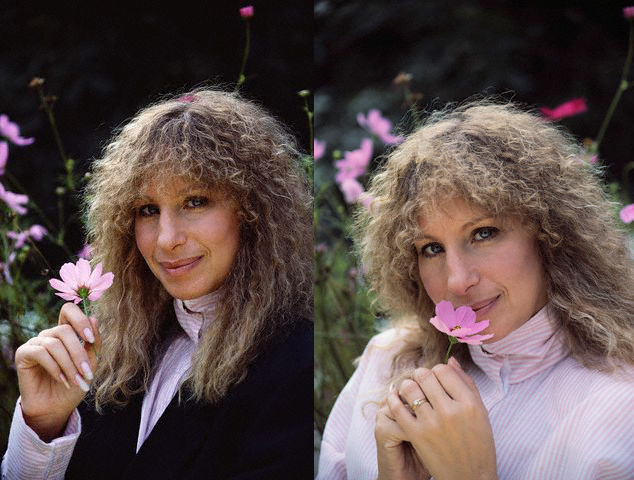
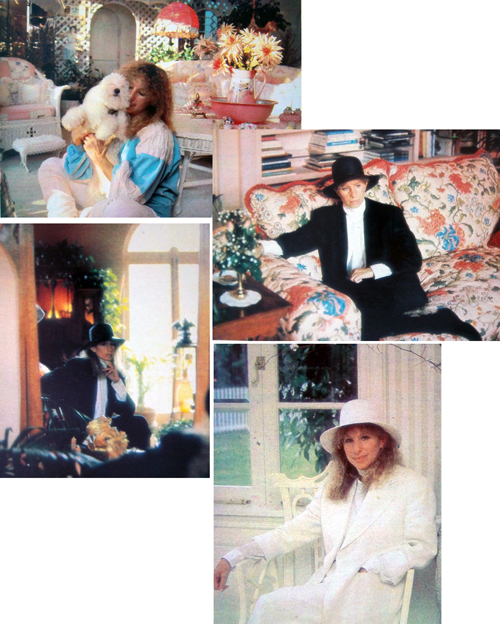
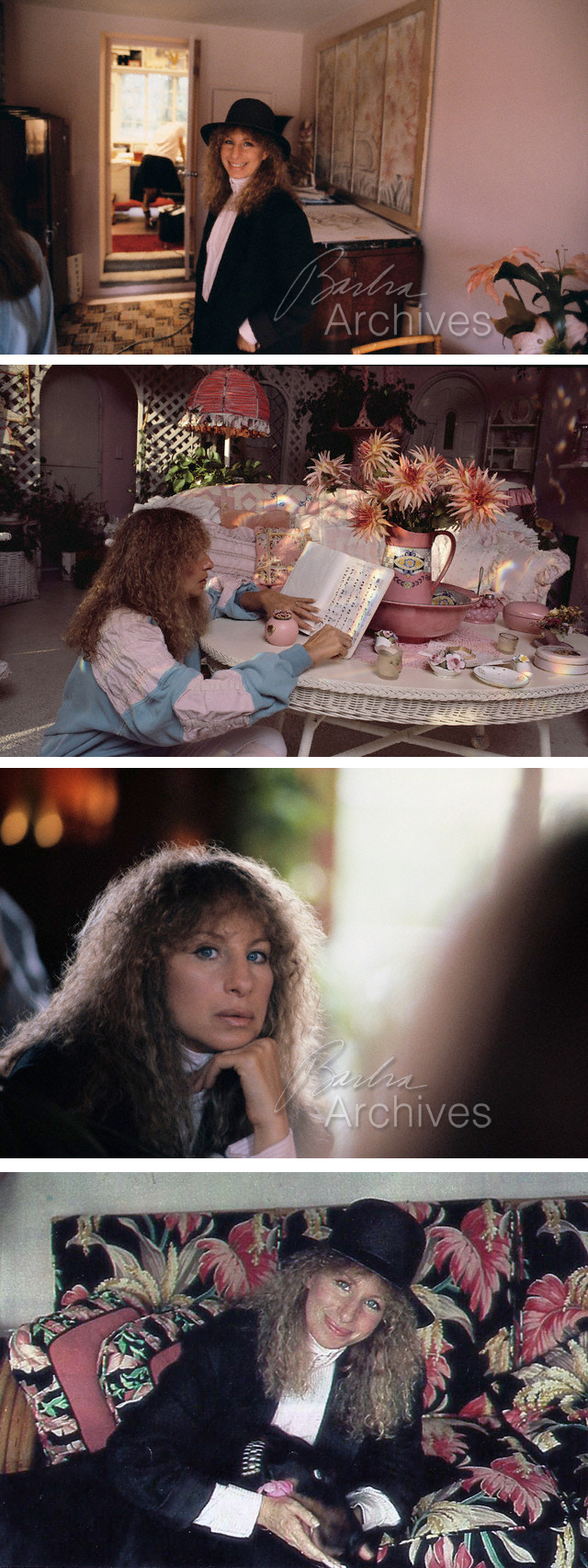
[ top of page ]
